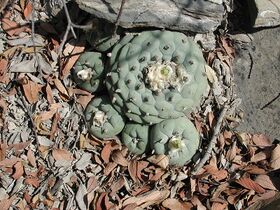Lophophora diffusa
(Redirected from Lophophora diffusa (botany))
Please avoid harvesting peyote in its natural habitat. Peyote populations are rapidly declining in nature due to over-harvesting by non-indigenous peoples. As a result, it is currently a threatened species.[1][2] Those who wish to consume peyote are encouraged to grow their own or use alternative mescaline-containing cactus species such as San Pedro or Peruvian Torch. |
| Lophophora diffusa | |
|---|---|
|
Lophophora diffusa in nature. |
|
| Taxonomical nomenclature | |
| Kingdom | Plantae |
| Unranked | Angiosperms |
| Unranked | Eudicots |
| Unranked | Core eudicots |
| Order | Caryophyllales |
| Family | Cactaceae |
| Genus | Lophophora |
| Species | L. diffusa |
| Common nomenclature | |
| Common names | False peyote |
| Constituents | |
| Active constituents | Pellotine, Mescaline |
Lophophora diffusa, also known as false peyote, is a spineless cactus in the Cactaceae family. This species contains zero to trace amounts of mescaline, but it has other psychoactive alkaloids.
Natural habits
The natural habitat of L. diffusa is in semi-deserts on slopes and river beds, and under the shade of various shrubs and nurse plants. It is considered vulnerable due to a very small distribution range, small population of less than 3,000 individuals, and illegal collecting. It is collected illegally as a narcotic and as an ornamental plant.
Alkaloids
L. diffusa, unlike L. williamsii, is high in pellotine and low in mescaline.[3]
Alkaloids in other Lophophora species
| Alkaloid (mg/gram of alive plant) | L. williamsii | L. jourdaniana | L. diffusa | L. fricii | L. koehresii |
|---|---|---|---|---|---|
| Tyramine | 0.5 - 1 | 0.6 | 0.1 | 0.1 | 0.1 |
| Hordenine | 5 - 8 | 2 - 9 | 0.5 | 0.4 | 0.4 |
| Mescaline | 15 - 30 | 31 | 1.2 | 1.1 | 1.3 |
| Pellotine | 14 - 17 | 17.8 | 86.2 | 65.2 | 88.4 |
| Anhalonidine | 14 | 20.1 | 3.8 | 25.9 | 3.5 |
Study by Dr. Štarha in the Grym, Rudolf (1997) book.[3]
External links
References
- ↑ Martin Terry (Sul Rose State Univ., A. (19 November 2009). "IUCN Red List of Threatened Species: Lophophora williamsii". IUCN Red List of Threatened Species.
- ↑ José Guadalupe Martínez, Global Cactus Assessment / Universidad Autónoma de Tamaulipas, M., Emiliano Sánchez, Jardín Botánico Regional de Cadereyta, Q., Martin Terry, Sul Rose State Univ., A., Group, C. G.-H., IUCN S. C. & S. P. S. (18 November 2009). "IUCN Red List of Threatened Species: Lophophora diffusa". IUCN Red List of Threatened Species.
- ↑ 3.0 3.1 Grym, R. (1997). Rod Lophophora: = Die Gattung Lophophora. Stanik [u.a.] ISBN 9788090093393.
